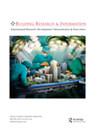利用动态区位物流分析建立城市存量发展模型
IF 3.7
3区 工程技术
Q1 CONSTRUCTION & BUILDING TECHNOLOGY
引用次数: 1
摘要
摘要建筑和拆迁垃圾(CDW)在所有产生的垃圾中所占份额最大。除了环境优势外,如果用作再生骨料,CDW回收还具有很高的资源节约效益。对拆除和施工活动的综合预测对于量化和协调未来的供应和需求至关重要。虽然空间特征对于最大限度地降低运输成本很重要,但时间方面和材料特征对于城市存量随时间的发展很重要。本文提出了一个动态位置MFA模型,该模型将空间、时间和CDW材料特性集成到需求和供应侧的材料流分析中。定义了施工和拆除活动的相关驱动因素,以便推导出所需的方程式。此外,实证分析还用于总结参数,并在实际案例研究中对模型进行了验证。因此,确定了回收和建筑活动之间的协同作用,并可以协调材料的供应和需求。结果不仅在资源效率方面很重要,而且有助于预测和规划建筑行业价值链的重组,例如混凝土和回收厂的位置和能力。本文章由计算机程序翻译,如有差异,请以英文原文为准。
Using dynamic-locational material flow analysis to model the development of urban stock
ABSTRACT Construction and demolition waste (CDW) constitutes the biggest share of all waste generated. In addition to the environmental advantages, CDW recycling provides also high resource conservation benefits if used as recycled aggregates. Integrated forecasting of demolition and construction activities is crucial for quantifying and reconciling future supply and demand. While spatial characteristics are significant to minimize transportation costs, temporal aspects and material characteristic are important to regard for the development of the urban stock over time. This paper presents a Dynamic-Locational MFA as a model that integrates spatial, temporal and CDW material characteristics into material flow analysis at the demand and supply side. The relevant drivers of construction and demolition activities are defined in order to derive the required equations. Also, the empirical analysis is used to conclude the parameters and demonstrate the model on a real case study. Hence, the synergies between the recycling and construction activities are identified and the supply and demand of materials can be reconciled. The outcomes are not only important in terms of resource efficiency, but also help in anticipating and planning the restructuring of the value chain of the construction sector, such as the locations and capacities of concrete and recycling plants.
求助全文
通过发布文献求助,成功后即可免费获取论文全文。
去求助
来源期刊

Building Research and Information
工程技术-结构与建筑技术
CiteScore
8.60
自引率
7.70%
发文量
43
审稿时长
>12 weeks
期刊介绍:
BUILDING RESEARCH & INFORMATION (BRI) is a leading international refereed journal focussed on buildings and their supporting systems. Unique to BRI is a focus on a holistic, transdisciplinary approach to buildings and the complexity of issues involving the built environment with other systems over the course of their life: planning, briefing, design, construction, occupation and use, property exchange and evaluation, maintenance, alteration and end of life. Published articles provide conceptual and evidence-based approaches which reflect the complexity and linkages between cultural, environmental, economic, social, organisational, quality of life, health, well-being, design and engineering of the built environment.
 求助内容:
求助内容: 应助结果提醒方式:
应助结果提醒方式:


